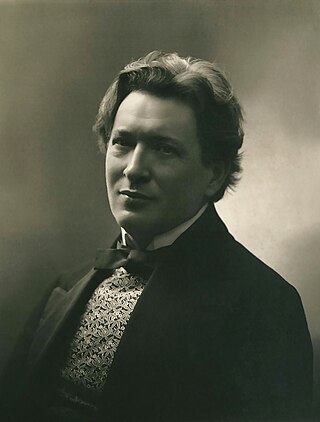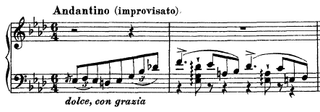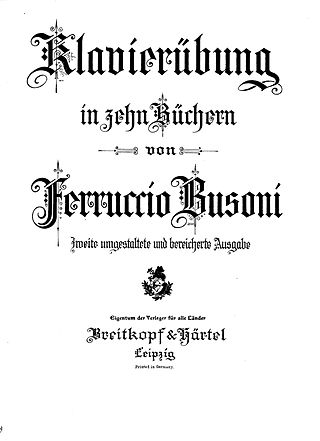
Ferruccio Busoni was an Italian composer, pianist, conductor, editor, writer, and teacher. His international career and reputation led him to work closely with many of the leading musicians, artists and literary figures of his time, and he was a sought-after keyboard instructor and a teacher of composition.

The Fantasy on Themes from Mozart's Figaro and Don Giovanni, S.697, is an operatic paraphrase for solo piano by Franz Liszt, based on themes from two different Mozart's operas: The Marriage of Figaro, K.492 and Don Giovanni, K.527.

Fantasia contrappuntistica(BV 256) is a solo piano piece composed by Ferruccio Busoni in 1910. Busoni created a number of versions of the work, including several for solo piano and one for two pianos. It has been arranged for organ and for orchestra under the composer's supervision.

En saga, Op. 9, is a single-movement tone poem for orchestra written from 1891 to 1892 by the Finnish composer Jean Sibelius. The piece, which likely began as a septet or octet for flute, clarinet, and string ensemble before evolving into an orchestral tone poem, premiered on 16 February 1893 in Helsinki with Sibelius conducting the Helsinki Orchestral Association. A decade later in 1902, Sibelius substantially revised En saga in response to an invitation from Ferruccio Busoni to conduct the piece in Berlin. It thus stands alongside The Lemminkäinen Suite (Op. 22), the Violin Concerto (Op. 47), The Oceanides (Op. 73), and the Fifth Symphony (Op. 82) as one of the most overhauled works in his œuvre. The Berlin concert, which occurred a fortnight after Robert Kajanus had premiered the revised version in Helsinki on 2 November, finally brought Sibelius the German breakthrough he had long desired.

Transcendental Étude No. 9 in A♭ major, "Ricordanza" is the ninth of twelve Transcendental Études by Franz Liszt. It has wild but gentle cadenzas and demands delicate finger work. There are some areas with syncopation similar to Frédéric Chopin's Étude Op. 10, No. 3. This is a good introduction to Liszt's pianistic style.

The Piano Concerto in C major, Op. 39 (BV 247), by Ferruccio Busoni, is one of the largest works ever written in this genre. Completed and premiered in 1904, it is about 70 minutes long and laid out in five movements played without a break; in the final movement a quiet men's chorus intones words from the verse-drama Aladdin by Adam Oehlenschläger.

Natalie Curtis, later Natalie Curtis Burlin was an American ethnomusicologist. Curtis, along with Alice Cunningham Fletcher and Frances Densmore, was one of a small group of women doing important ethnological studies in North America at the beginning of the 20th century. She is remembered for her transcriptions and publication of traditional music of Native American tribes as well as for having published a four-volume collection of African-American music. Her career was cut short by her accidental death in 1921.

Turandot(BV 273) is a 1917 opera with spoken dialogue and in two acts by Ferruccio Busoni. Busoni prepared his own libretto, in German, based on the play of the same name by Count Carlo Gozzi. The music for Busoni's opera is based on the incidental music, and the associated Turandot Suite, which Busoni had written in 1905 for a production of Gozzi's play. The opera is often performed as part of a double bill with Busoni's earlier one-act opera Arlecchino.

Ferruccio Busoni discography is a list of recordings of music composed or adapted by Ferruccio Busoni. For recordings of music with Busoni as pianist, see Ferruccio Busoni discography.

The Klavierübung, by the Italian pianist-composer Ferruccio Busoni, is a compilation of piano exercises and practice pieces, comprising transcriptions of works by other composers and original compositions of his own.

The Bach-Busoni Editions are a series of publications by the Italian pianist-composer Ferruccio Busoni (1866–1924) containing primarily piano transcriptions of keyboard music by Johann Sebastian Bach. They also include performance suggestions, practice exercises, musical analysis, an essay on the art of transcribing Bach's organ music for piano, an analysis of the fugue from Beethoven's 'Hammerklavier' sonata, and other related material. The later editions also include free adaptations and original compositions by Busoni which are based on the music of Bach.

The Turandot Suite, Op. 41 is an orchestral work by Ferruccio Busoni written in 1904–5, based on Count Carlo Gozzi's play Turandot. The music – in one form or another – occupied Busoni at various times between the years 1904–17. Busoni arranged the suite from incidental music which he was composing to accompany a production of Gozzi's play. The suite was first performed on 21 October 1905, while the play with his incidental music was not produced until 1911. In August 1916 Busoni had finished composing the one-act opera Arlecchino, but it needed a companion work to provide a full evening's entertainment. He suddenly decided to transform the Turandot music into a two-act opera with spoken dialog. The two works were premiered together as a double-bill in May 1917.
Berceuse élégiaque, Op. 42 (BV 252a), is an orchestral work composed by Ferruccio Busoni in 1909. Originally written for solo piano, to be added as the seventh piece in his 1907 collection Elegies, Busoni adapted it for orchestra later the same year. This orchestral version was sub-titled "Des Mannes Wiegenlied am Sarge seiner Mutter". The first performance of Berceuse élégiaque was in New York City on February 21, 1911, and was conducted by Gustav Mahler in his last concert concert before his death.
Carlo Grante is an Italian classical pianist. Born in L'Aquila and graduating from the National Academy of St Cecilia in Rome, he performs classical and contemporary classical music. His discography consists of more than 50 albums.

Giovanni Bellucci is an Italian pianist.
Wilhelm Mayer was an Austro-Bohemian composer who published his works under the name W. A. Rémy. He was also a noted teacher, whose pupils included Ferruccio Busoni and Felix Weingartner. His name sometimes appears as Wilhelm Mayer-Rémy.

Ferruccio Busoni composed his Concerto for Piano and String Quartet in D minor, Op. 17, BV 80, in 1878, at the age of twelve. The original title was Concerto per piano-forte con accompagnamento di quartetto ad arco, Op. 17. Conceived for string quartet, the piano can also be accompanied by a string orchestra as Concerto for Piano and Strings, the title under which it was published in 1987.
Günter Ludwig was a German pianist.














